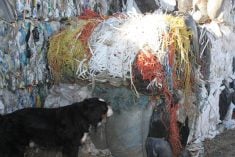Compensation value for white-tailed deer being slaughtered to control chronic wasting disease is proving difficult to determine because producers no longer have access to lucrative American markets, said the executive director of the Alberta Whitetail and Mule Deer Association.
“The market still exists but the access to the market is hampered right now and it creates huge distortion in prices,” said Murray Greer.
Canadian Food Inspection Agency officials and producers with animals that must be slaughtered so they can be tested for chronic wasting disease must agree on a market price in an unnaturally distorted market, said Greer.
Read Also

Message to provincial agriculture ministers: focus on international trade
International trade stakeholders said securing markets in the face of increasing protectionism should be the key priority for Canada’s agriculture ministers.
“Right now in Alberta our borders are closed and all of a sudden we have a local issue that really affects the market value.”
Last fall, one white-tailed deer tested positive for chronic wasting disease and now the entire 350 deer herd where it originated must be destroyed to carry out CWD tests. There are no live animal tests for the disease.
Nineteen animals originating from the infected herd and traced to two other farms, as well as another single animal at the originating farm but with a different owner, must also be tested. Eleven of the 19 animals have already been slaughtered.
Deer producers’ most lucrative market is selling animals to American hunt farms each fall. But the border was closed before many of the Alberta deer producers could sell their animals last fall.
Jason Marsland, president of the Alberta Whitetail and Mule Deer Association, said when the ban on selling animals to the United States is lifted, prices will bounce back and compensation prices should reflect that.
CFIA will pay producers based on fair market value to a maximum of $4,000 per animal. A coalition of elk and deer producers has been formed to try and convince CFIA officials to establish a fair market price based on real market conditions, not unnaturally low prices because of the closed border.
George Luterbach, CFIA’s chief veterinarian, said compensation is only one of the stumbling blocks to slaughtering the white-tailed deer herd in Alberta.
“It’s complex logistics in disposal of large number of animals,” said Luterbach. “We establish market value prior to destroying the animals. Part of the logistics of dealing with an infected herd is to work through evaluation, work through disposal and logistics of sampling,” he said.
An elk herd where a single animal tested positive for the disease earlier in the year was incinerated. A decision was made to bury the white-tailed deer.
“We’re hopeful within the next few weeks we’ll get a break in the weather and we’ll be able to get it done,” said Luterbach.














